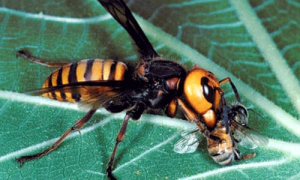A new pest has made its appearance in the United States. The Asian giant hornet, Vespa mandarinia was first seen in Blaine, Washington in the Fall of 2019. Originally from Japan, it has spread to many Asian countries and now to the United States. Luckily, this hornet is nowhere near Florida and an eradication program is underway in Washington state.
Biology

Compared to other hornets, the Asian giant hornet has a wider head with the front of the “face” above the mandibles being deeply scalloped along the edge. Its large mandibles are used to overpower prey. In size, adult workers and their queen are 2 inches long.
In coloration, the head is orange yellow, the banding on the abdomen is yellow and brown and the last segment is yellow. It has two pairs of wings.
This is not a hornet you want to mess with. In China, during a four month period in 2013, 42 deaths and 1,675 injuries were reported. The primary causes of death included anaphylactic shock, kidney failure, heart attack and multiple organ failures.
Allergic reactions to insect stings range in severity. This range include:
- Slight general reactions include inflammation, welts, itching and anxiety.
- General reactions include swelling, wheezing, abdominal pain, nausea and/or vomiting.
- Severe reactions include difficulty in breathing and swallowing, hoarseness and confusion.
- A shock reaction includes a blue coloration of skin and lips, a fall in blood pressure, collapse, unconsciousness.
These reactions can be caused by the sting from bees, fire ants, wasps, yellow jackets, or hornets (including the Asian Giant Hornet).
Ways to prevent stings include:
- Avoid mowing lawns or working with flowering ornamentals when bees or wasps are collecting nectar.
- Do not walk barefoot in the yard.
- Sweet items like soft drinks, ripened fruits and watermelons attract bees and wasps. Keep these items covered when outdoors.
- Pick fruit as it ripens and dispose of rotten fruits.
These hornets prefer to nest in temperate regions, including mountainous areas, but can also be found in some subtropical environments.
Life Cycle
The life cycle, starts in the spring, with the mated queen emerging from diapause (period of postponed development). Queens feed on tree sap for energy. The typical location of a colony would be in a cavity or hollow area near the root of the tree. The queen will search for woody material for fibers. The fibers are manipulated by the queen’s mandibles into cells surrounding comb. To enlarge the colony space, balls of soil are removed from the surrounding soils.
When the workers emerge from these original cells, they take over safeguarding the colony. In a mature hive the queen has around 1,000 cells available to lay eggs in. The larvae stay in a cocoon for about 18 days. In the fall, towards the end of October, male hornets leave the nest and wait to mate with new queens. A new queen mates only with one male before searching for a place in the soil to overwinter. The new queens can overwinter for up to seven months. In the original hive, the founding queen dies in November and the hive weakens as workers die off and are not replaced.
Predatory Strategies

Predatory strategies for hornets include two main attack methods. The first is a lone hunting mode. In the lone hunting mode, a single hornet captures an individual honeybee outside the beehive entrance. The worker detaches the head from the thorax and chews its prey into a gummy paste for transportation to the nest where the paste is fed to larvae. The larva chew on the paste and emit a liquid substance the adult hornet can eat. Hornets take bees from many colonies. This strategy is shared by other invasive wasp species, such as the Vespa velutina, weakening about 30% of beehives.
The second attack strategy is the slaughter strategy. This strategy involves groups of 10-20 nestmates staging a coordinated attack on a single colony. An entire honeybee hive of 30,000 individuals can be destroyed in several hours. The European honeybee, Apis mellifera are defenseless against this predator.
Managing this Pest
Beekeepers have developed strategies to manage the damage this hornet can cause. One strategy has the beekeepers using mechanical devices such as a specially designed screens to physically exclude the hornet from the hive entrance. Continuous monitoring and subsequent elimination of hornet colonies prevents hornet establishment.
The honeybee plays a huge role in the pollination of crops. Hornet predation of the honeybee can result in a huge economic impact, first to beekeeper and second to the crops that a dead honeybee cannot pollinate.
How this hornet was introduced into the US is unknown. Again, it has not been reported in Florida or anywhere in the US besides a small part of Washington State. However, new invasive insects and plants find their way to Florida and it is important to learn about potential invaders. Keep in mind there are a lot of large native wasps and hornets in Florida that can easily be confused with this invasive species due to size. Most are important in our ecosystem and do not warrant control.
Written by UF/IFAS Columbia County Master Garden Volunteer Marge Anderson
Sources:
http://edis.ifas.ufl.edu/ig099
http://entnemdept.ufl.edu/creatures/u
https://edis.ifas.ufl.edu/in238
 0
0
